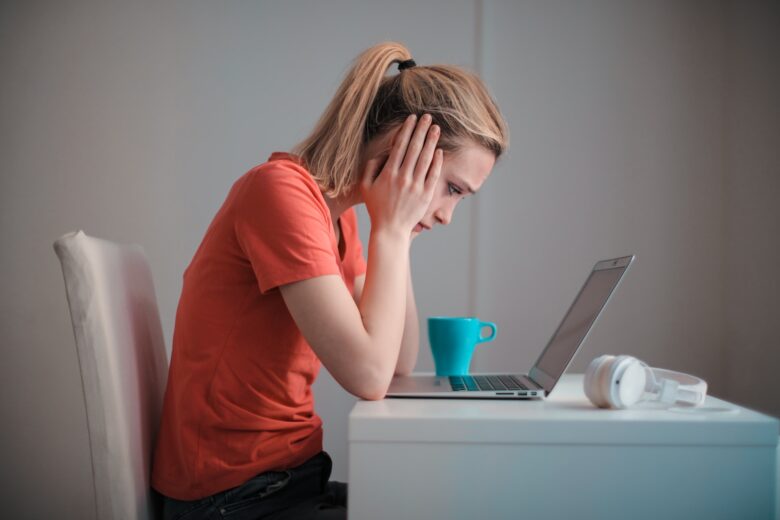Whether working in an office or from home, it can be difficult getting work done when a headache starts. The pain can make it difficult to see or even think clearly. If these headaches are a regular occurrence, it might be time to check the lighting.
Improper lighting when working can cause a plethora of problems. These problems can include dry, watery, or irritated eyes. Some people have issues with double vision or even eye pain. And many people who work with improper lights get regular headaches while at work. Fortunately, there are some tips that can help identify the problem and take steps to correct it.
Fluorescent Lighting

Many office buildings use fluorescent lighting to illuminate offices. This is because fluorescent lighting can provide large amounts of light at a very low cost. Unfortunately, fluorescent lighting is very harsh on the eyes. MakeGreatLight filters are an option to help with fluorescent light glare.
Fluorescent lighting can create a lot of visual issues, especially when required to sit under those lights for eight or more hours a day. These lights are very bright and can often cause the eyes to strain in an attempt to prevent too much light from entering.
Working under this lighting can cause glare on computer screens and other work materials that a person may need to look at or read for several hours at a time. Before long, a person may feel like their eyes are getting tired.
For some, it can become harder to focus, and their eyes may begin to feel irritated or even watery. Pain and pressure may also begin to creep in around the eyes. Vision can become blurred or even doubled when trying to focus. As the eyes continue to strain to see, headaches can develop with or without the previous symptoms.
There are light filters available that can help soften the harsh glare caused by fluorescent lighting. These filters can be easily installed directly on the fluorescent lights. This filter helps to minimize the glare and harshness of fluorescent lighting. This can have a great benefit on a person’s eyes and minimize headaches caused by eye strain.
Dim Lighting

Fluorescent lighting causes issues and pain due to excessive light and glare. However, not having enough light to see properly can be just as problematic as the bright lights. When there is insufficient lighting, the eyes will expand to take in more light. This can make it harder to focus and cause the eyes to strain to see properly.
Eye strain in dim lighting can cause much of the same symptoms as those with bright fluorescent lights. Eyes become tired quicker. Vision can become blurry or even doubled. Headaches can become commonplace due to the strain on the muscles in the eyes or even the head and neck from trying to adjust to seeing things better.
Poor lighting can also pose risks to one’s productivity. Not only will the headaches and eye strain make it harder to stay working, but it can also dampen a person’s mood and reduce energy. This can be a big problem when working from home because it can be all too tempting to take extra breaks or just go to bed.
More lighting is needed to help stay productive and reduce eye strain. However, it is important to prevent too much lighting or lights that make a lot of glare in the work area. Never work under the direct glare of overhead lights.
It is important to add extra lighting without creating glare or casting shadows. Lampshades can assist in scattering the light to prevent glare. Even an upward-facing lamp can be a benefit because it bounces the light off the ceiling and walls, providing a more scattered light that illuminates without the glare.
Blue Light

Blue light is everywhere. Blue light is a visible light that is emitted from the sun. It is considered to be about a third of all visible light. Most exposure to blue light is outside during daylight hours. Blue light can have many benefits but can also have dangers.
Although most people are exposed to plenty of blue light throughout the day, there are many man-made sources that people spend a lot of time focused on during their daily routine, especially at work. Display screens from computers and phones, as well as LED lighting and flat-screen TVs, emit significant amounts of blue light.
Although the blue light emitted from these devices is minor compared to that of the sun, most people do not stare at the sun for hours at a time. The eye is pretty good at blocking the sun’s UV rays from reaching the sensitive retina. Unfortunately, blue light passes straight through to the retina.
Excessive amounts of blue light throughout the workday can contribute to eye strain. As previously discussed, eye strain can lead to all sorts of vision issues and even headaches. This can make it harder to work and be productive.
In addition to causing eye strain, there are studies showing that excessive amounts of blue light exposure can damage the retina. There is even some suggestion that this damage is similar to or may even cause macular degeneration. This is an eye disease that can lead to permanent loss of vision.
Fortunately, there are methods available for blocking out excessive blue light when using digital screens for long periods of time. There are filters that can be placed directly on the screens of computers, tablets, TVs, and even smartphones. There are even special glasses available that can block the blue light while working.
Natural lighting is always the best option to protect the eyes. Unfortunately, it can be difficult or impossible to completely depend on natural lighting for a work area. Even with proper lighting and protective filters, eye strain can still occur when focusing too long on something, especially computer screens.
It is best to follow a few steps to help keep the eyes rested and comfortable throughout the workday. When working on a screen, look at something at least twenty feet away for twenty seconds after every twenty minutes of work. It is also important to drink plenty of water. Keeping the eyes hydrated reduces eye strain. These tips can help anyone see clearer, reduce pain, and be more productive at work.


